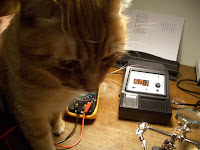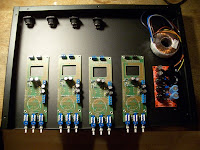So I had the pcb kits (which were very simple to assemble) together in a few hours the day after I bought them. Ok, admittedly I asked Chris a pile of really stupid questions while assembling everything. After a a short time he just kind of stopped replying. Completely understood, heh heh, sorry for hassling you Chris.






That was at the beginning of November. It's now mid January and I'm finally pulling together the last pieces. Since then I've learned a lot about electronics and have answered a lot of the dumb questions on my own. Understanding how to properly power multiple loads with one power supply was a stepping stone. Understanding what makes a preamp sound different from another preamp was another.
Transformers and Op Amps
Instead of trying to accurately reproduce the original API 312 with the exact same transformers and 2520 opamps, I decided to follow 3nity's suggested use of Cinemag input and output transformers (same used in the A-Designs Pacifica which is a giant plus in my books). And after researching which opamp I decided on the John Hardy 990c. There are lots of opamp manufacturers out there that make a 990 DOA based on the original Jensen design that fits in the API 2520 footprint. It was down to the JLM and the Hardy. I ended up choosing (from what I read about them) the cleaner of the two. (There is a great list of 2520 compatible OpAmps at the Eisen Audio site http://www.eisenaudio.com/diy500/tables/opamps/). The Cinemag transformers and Hardy Opamps are in the mail right now. I should receive them any day now.
Voltage and Current Draw
In the mean time I did a bunch of reading on powering the preamps. Besides the +48 dc phantom supply, the opamp is what requires power on the preamp board. Therefore, the opamp defines the voltage required and the minimum current draw. The API 2520 and and all API VPR 500 series stuff requires +/-16 V. To some this is the downside of the 500 series because lower powered pre's supposedly have less headroom.
The Hardy 990c can operate from +/-15 Volts to +/- 24 Volts. I reckon I can test different voltages to see how true this theory of lower volts = lower headroom, but likely I will get it working somewhere in the neighborhood of +/-18 Volts and leave it there.
As John Hardy kindly informed me, the supply current draw of the 990c is 25mA unloaded, therefore the power supply needs to deliver +/-18Volts at 100mA. I was stuck on this question for a while.
The Power Supply
So the voltage and current draw questions had been solved, but what about the mains transformer? How does it play into the mix. I guess it was kind of working backwards because I had sorted out why I need a rectifier, regulator, etc. but the step down voltage from 110 to ? was the question. Actually, that's a lie, I still don't really understand +/- dc voltage. That's baffling.
With important questions left to be answered (questions that might jeopardize my safety when I power up... at least I know what not to do with electronics) I decided to buy a PSU kit from Five Fish Audio. Recommended by 3nity, it is an 18 - 24 volt regulated power supply with a step down transformer. It even has 4 separate outputs for 4 preamps. Pretty simple-stupid really.... awesome! Just right for a noob tech like me.
The package from Five Fish arrived yesterday so I quit talking to my girlfriend for the evening and got to work. Here's how it went...



The kit laid out. Construction begins...




Dammit! What?



Ok, finished. I was going to test the PSU but decided to wait 'cause it was getting late.
Laid it all out in case with incomplete 312 boards instead.

And... couldn't help myself, I had to start drilling the blank front panel.



2:30am, that's it for now.



















